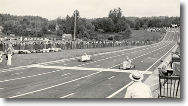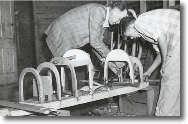The Soap Box Derby brought many thousands of people to Mission every
year during its run and up to 20,000 at its peak. It began in 1946 after
local business men and the Board of Trade decided to hold a Strawberry
Festival in Mission. The goal was to provide funding for a much needed
addition to the hospital after the war and to make Mission synonymous
with strawberries. Jimmy Gunn, a committee member on the Board of Trade,
thought of putting on a Soap Box Derby in conjunction with the Strawberry
Festival. Both events were held on Main Street from Grand to Horne Street.
 Boys
aged from 11 to 16 years of age were allowed to enter. In the following
years the soap box cars had to be built to strict specifications by the
boys, without receiving any outside help other than advice. The boys usually
spent two to three months working on their cars, which were carefully
inspected for safety and eligibility at each derby.
Boys
aged from 11 to 16 years of age were allowed to enter. In the following
years the soap box cars had to be built to strict specifications by the
boys, without receiving any outside help other than advice. The boys usually
spent two to three months working on their cars, which were carefully
inspected for safety and eligibility at each derby.
Mission's first derby in 1946 (a "wildcat" race) was
a big success, and  the
following year, Mission's Soap Box Derby became a franchise of
the American Soap Box Association. Becoming affiliated with the
American Soapbox Association meant that the winner in Mission
went to Akron, Ohio to race in the All-American Soapbox Derby
Championship finals. In 1949, the increasing popularity of the
derby caused it to remain on Main Street while the festivities
of the Strawberry Festival were moved to the Fairgrounds (now
the site of the Leisure Center).
the
following year, Mission's Soap Box Derby became a franchise of
the American Soap Box Association. Becoming affiliated with the
American Soapbox Association meant that the winner in Mission
went to Akron, Ohio to race in the All-American Soapbox Derby
Championship finals. In 1949, the increasing popularity of the
derby caused it to remain on Main Street while the festivities
of the Strawberry Festival were moved to the Fairgrounds (now
the site of the Leisure Center).
By 1950, the derby was a province wide contest. Teams of volunteers
and sponsors, including GM Motors and Shell Oil, all pooled their resources
to ensure the event ran smoothly. In 1953, to accommodate the derby's
increasing popularity, the city of Mission built a new track at the Fairgrounds
to the same specifications as the track in Akron. Many considered the
event a "character building experience" for the boys and the
network of adults that supported them. The whole community that had worked
diligently to make the derby a success was repeatedly praised by neighboring
communities and beyond.
 The
derby's success surpassed everyone's expectations and in 1956
the Strawberry Festival was dropped to handle the derby exclusively.
In 1958 the derby had over 200 contestants, representing over
40 different communities. However, the increasing number of entries
and competition to build better cars contributed to decrease in
local entries. The cost of staging the event had also increased
with the rise in notoriety. Because income from the Strawberry
Festival had offset a considerable part of the cost of staging
such an enormous event, it was becoming more and more difficult
to continue on revenues from the derby alone. Although the Soapbox
Derby had a multitude of sponsors, they did not provide sufficient
monetary contributions to offset the costs.
The
derby's success surpassed everyone's expectations and in 1956
the Strawberry Festival was dropped to handle the derby exclusively.
In 1958 the derby had over 200 contestants, representing over
40 different communities. However, the increasing number of entries
and competition to build better cars contributed to decrease in
local entries. The cost of staging the event had also increased
with the rise in notoriety. Because income from the Strawberry
Festival had offset a considerable part of the cost of staging
such an enormous event, it was becoming more and more difficult
to continue on revenues from the derby alone. Although the Soapbox
Derby had a multitude of sponsors, they did not provide sufficient
monetary contributions to offset the costs.
In the following years, the Soapbox Derby became more and more difficult
to put on, due to a lack of funds and declining local interest. Eventually,
GM Motors withdrew their sponsorship and the event was dropped in 1974.